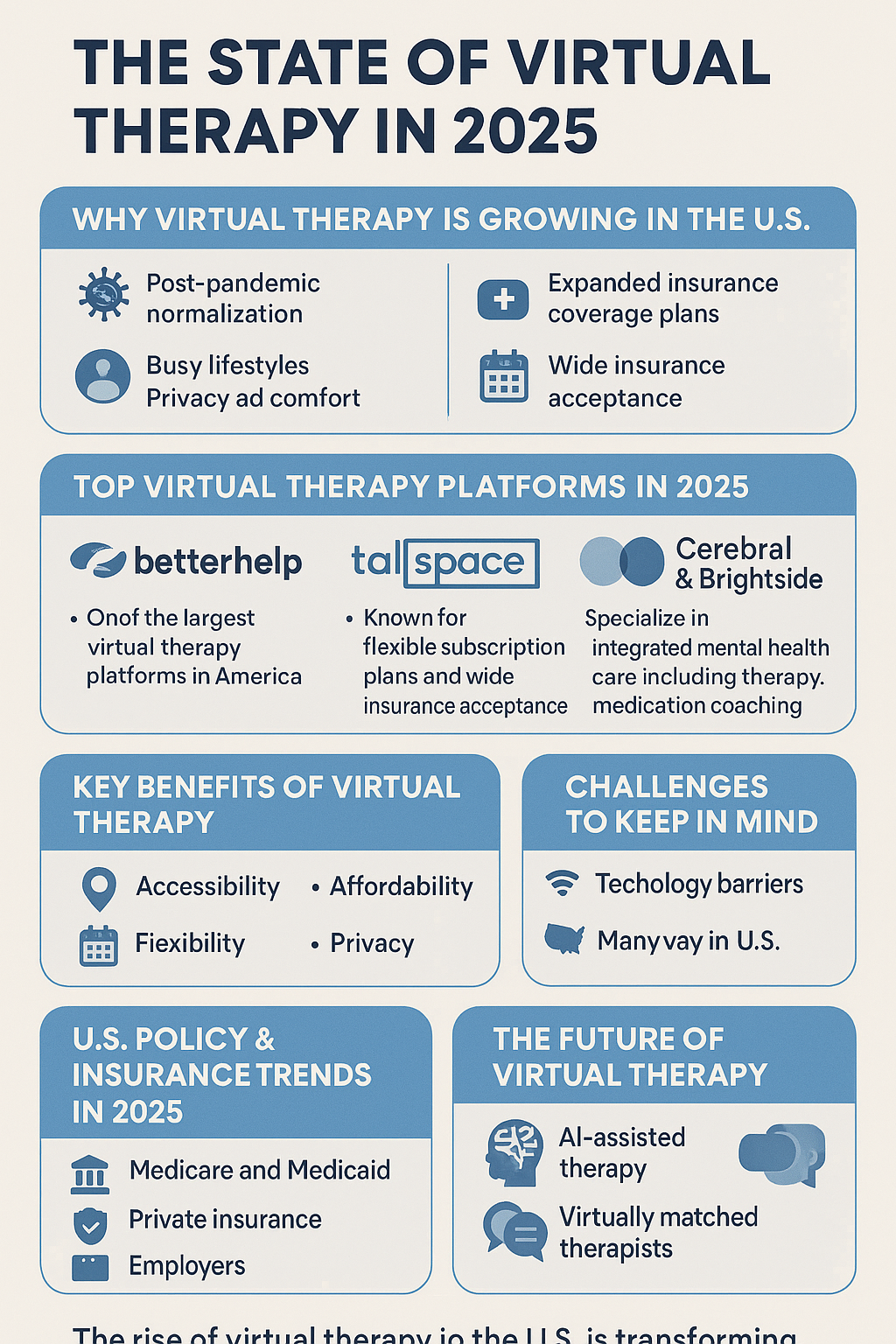
- July 29, 2025
- admin
- 0
In 2025, virtual therapy in the United States has officially moved from being an alternative option to a mainstream choice for mental health care. Thanks to advancements in technology, shifting attitudes toward mental wellness, and better accessibility, online counseling is reshaping the way Americans connect with licensed therapists, manage emotional well-being, and access professional support from the comfort of home.
Why Virtual Therapy Is Growing in the U.S.
Several key factors are driving the rapid adoption of online therapy services:
Post-pandemic normalization – After 2020, remote care became widely accepted.
Expanded insurance coverage – More plans now cover teletherapy sessions.
Busy lifestyles – Online appointments save time compared to office visits.
Privacy and comfort – Many people feel more relaxed attending sessions at home.
Top Virtual Therapy Platforms in 2025
Several platforms are leading the way in online counseling in the U.S.:
BetterHelp
One of the largest virtual therapy platforms in America.
Offers text, video, and phone therapy sessions with licensed professionals.
Talkspace
Known for flexible subscription plans and wide insurance acceptance.
Works with many major U.S. health insurance providers.
Cerebral & Brightside
Specialize in integrated mental health care including therapy, medication management, and coaching.
Key Benefits of Virtual Therapy
Online counseling provides multiple advantages for Americans seeking mental health support:
Accessibility – Connect with therapists anywhere in the country.
Affordability – Often more cost-effective than in-office visits.
Flexibility – Evening, weekend, and on-demand sessions are common.
Privacy – Discreet sessions help reduce stigma.
Challenges to Keep in Mind
While teletherapy in the U.S. is growing, there are still challenges:
Technology barriers – Requires stable internet and a compatible device.
Licensing rules – Many therapists must be licensed in your state.
Insurance variations – Coverage depends on your provider and plan.
Not for emergencies – Crisis situations still require in-person help.
U.S. Policy & Insurance Trends in 2025
The government and insurers are expanding support for virtual mental health services:
Medicare and Medicaid now cover more teletherapy options.
Private insurance offers equal coverage for virtual and in-person care.
Employers are adding virtual therapy stipends to employee benefits.
The Future of Virtual Therapy in the U.S.
Emerging technology is shaping the next phase of online mental health treatment:
AI-assisted therapy for intake and journaling.
Virtual reality (VR) therapy rooms for immersive treatment.
Culturally matched therapists who share a client’s language or background.
Frequently Asked Questions About Virtual Therapy
1. Is virtual therapy as effective as in-person sessions?
Yes—studies show similar results for many mental health concerns.
2. Is virtual therapy covered by insurance?
Many plans cover it, but always check with your provider.
3. Can I switch between virtual and in-person sessions?
Yes, many therapists now offer hybrid therapy options.
4. Are virtual sessions secure?
Reputable platforms use HIPAA-compliant systems.
5. What if I need emergency help?
Call 988 or visit an ER for immediate assistance.

Conclusion
The rise of virtual therapy in the U.S. is transforming mental health care in 2025 and beyond. With better accessibility, supportive policy changes, and evolving technology, online counseling offers a flexible and effective path for Americans to prioritize mental wellness—breaking down traditional barriers to care.


